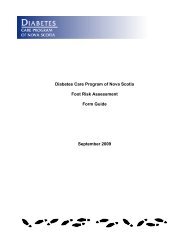CDE Appendix 1 Literature Review - Central East Local Health ...
CDE Appendix 1 Literature Review - Central East Local Health ...
CDE Appendix 1 Literature Review - Central East Local Health ...
Create successful ePaper yourself
Turn your PDF publications into a flip-book with our unique Google optimized e-Paper software.
The Culture, Diversity and Equity Project: <strong>Literature</strong> <strong>Review</strong><br />
• To provide “a common understanding and consistent definitions of culturally and linguistically appropriate<br />
services in health care…Ideally, the issuance of national standards for CLAS should result in the<br />
replacement of the patchwork of different definitions and requirements with one universally understood set<br />
of guidance”; and finally<br />
• To “offer a practical framework for the implementation of services and organizational structures that can<br />
help health care organizations and providers be responsive to the cultural and linguistic issues presented by<br />
diverse populations” (Office of Minority <strong>Health</strong> 2001).<br />
The ‘ultimate aim’ of the standards is “to contribute to the elimination of racial and ethnic health disparities<br />
and to improve the health of all Americans” (Office of Minority <strong>Health</strong>, 2001);<br />
The 14 CLAS standards are thematically organized around three themes:<br />
Culturally Competent Care (Standards 1-3), Language Access Services (Standards 4-7), and Organizational<br />
Supports for Cultural Competence (Standards 8-14). Federally funded health care organizations are<br />
mandated to meet four of these standards (Standards 4-7) relating to language access services. This<br />
mandate derives from Title VI legislation of the 1964 Civil Rights Act which mandates that all institutions<br />
receiving federal funds provide adequate means of communication between English-speaking<br />
providers and individuals with limited English proficiency (LEP). The federal Office of Civil Rights<br />
defines an LEP individual as “someone who is unable to speak, read, write, or understand the English<br />
language at a level to interact effectively with health and social service agencies and providers” (cited in<br />
Rice 2007; also see Martinez et al., 2004).<br />
Promising state level policies, legislation and/or initiatives include:<br />
• New Jersey Senate Bill S-144, which was introduced in 1999 and signed into law in 2005. It requires that<br />
physicians in New Jersey to take cultural competency training as a condition of licensure by the State<br />
Board of Medical Examiners (see Salas-Lopez et al., 2007; also see Baquet et al., 2004);<br />
• The proposed Illinois Covered Act introduced into Illinois’ state legislature which would, among other<br />
things, establish a State <strong>Health</strong>care Workforce Council to provide an assessment of health care workforce<br />
trends with a focus on cultural competence and minority participation in health professions education<br />
(Smedley, 2008);<br />
• Pennsylvania’s governor, Ed Rendell's, proposed Cover All Pennsylvanians legislation which, if enacted,<br />
would similarly establish a Pennsylvania Center for <strong>Health</strong> Careers, among whose duties would be to<br />
develop recruitment and workplace tools that aim to improve health professional workforce diversity and<br />
promote the delivery of culturally appropriate care. In addition, this legislation would require charitable<br />
hospitals to produce a community needs assessment in consultation with community groups and local<br />
government officials (Smedley, 2008).<br />
• Various private, governmental, and non-profit organizations in the US have also increasingly come to adopt<br />
cultural competence policies, standards and training. Exworthy & Washington summarize the nature of such<br />
strategies and policies in Table 3.4 below:<br />
Table 3.4: Strategies to improve cultural competence at different levels in the US<br />
Source: Exworthy & Washington, 2006. Adapted from Betancourt et al., 2002.<br />
68

















